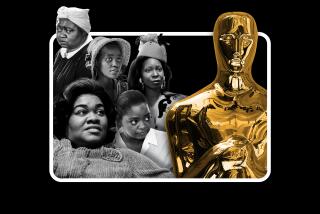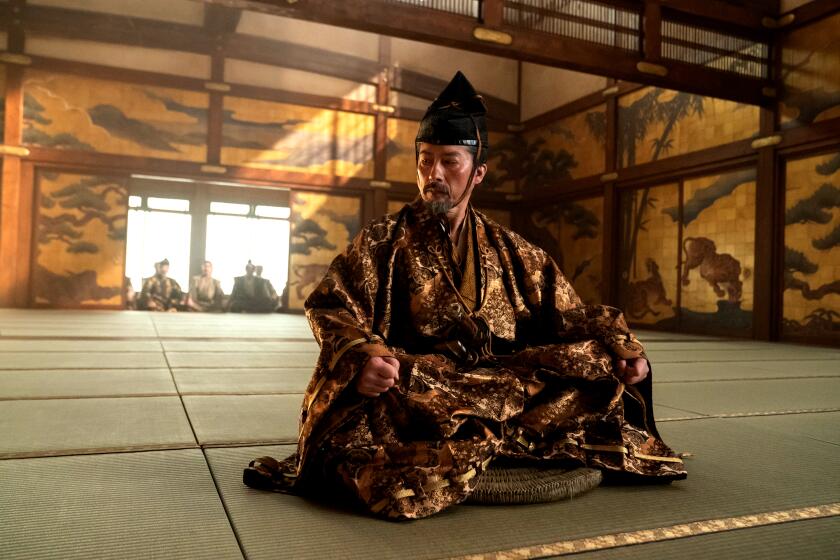Black and white movies today differ from those of yesteryear, reader says
I couldn’t disagree more strongly with Steven Zeitchik [“All in Black and White,” July 14] when he writes, “Because most movies are now shot digitally, modern black and white does have a different look than it did in the 20th century, offering sharper and more vivid contrasts.”
The issue with the current state of digitally shot and projected (particularly the latter) movies is that they simply cannot achieve true deep black — nor can they accurately depict shadow detail. For those who can’t see this for themselves, I have come up with a very simple test that one can do on the next trip to a movie theater: Look at the movie screen. Almost all theaters have either black cloth or painted black walls as a “frame” around the screen. While watching a digitally shot and projected movie, look at an object in the image that is black. Now, have your eyes drift over to the black “frame” around the screen. You will see that you never see the same level of true black in the movie as the “frame” around the movie. Never.
It’s great that moviemakers want to experiment with black and white in current releases. It’s just too bad they are more “gray and grayer” than black and white.
Joe Stemme
Culver City
Thank you for recognizing the importance of black and white films. When I taught a film studies class in high school, I warned students on the very first day that half of the films we would watch are in black and white, and if they can’t handle that they should switch classes now. Most hung in there. As we watched the original 1960 “Psycho,” we discussed why Alfred Hitchcock chose to shoot his film in black and white, even though color film was available. I then showed them the 1998 “Psycho” shot-by-shot color remake and asked which version they preferred, and which was more powerful. Every student chose the Hitchcock version.
Jerry Kazdoy
Valencia
::
I am puzzled why you did not mention the last “true” black and white film in current release, which was photographed on Kodak’s now-discontinued Plus-X film stock. All the current black and white movies you listed were achieved by shooting in color (either digitally or on film), yes, including “The Artist,” and then by digitally removing the color. “The Ghastly Love of Johnny X” is the last true black and white movie shot on 35-millimeter film and printed on 35-millimeter black and white film stock. It has played in theaters worldwide and locally. Is it safe to assume you only wanted to cover more mainstream films in your article?
Paul Bunnell
Director/producer of
“The Ghastly Love
of Johnny X,” Burbank
::
In proclaiming his intention for the sepia opening of “Oz the Great and Powerful” to differentiate his film from other multiplex epics, producer Joe Roth risks seeming disingenuous at best and pretentious at worst. Surely the most obvious reason for beginning his film monochromatically in Kansas before switching to Technicolor in Oz is to replicate the classic 1939 color scheme of “The Wizard of Oz.”
Preston Neal Jones
Hollywood
Woody Allen profile is precise
Mark Olsen’s write-up on Woody Allen [“Life … Take 2,” July 14] looked to be extremely accurate, with a plethora of personal items revealed about the man. To say that Allen’s films may be subtly sophisticated and at times even complicated would not be straying from the truth. To also say that his work delves into his personal self-examination is spot-on. And despite his 23 Academy Award nominations and four Oscar wins, but always a no-show for the Oscar show itself, may be his way of informing people that he feels he is undeserving of the accolades. However, through his work year after year, it is apparent that what he does is at the top of the heap: The line from his “Play It Again, Sam” “Yeah, I do have a certain amount of style, don’t I?” coincidently, thoroughly depicts his genius.
Bill Spitalnick
Newport Beach
Weight question is stunning
Irene Lacher finishes an interview with a bestselling author by asking, “How do you keep your girlish figure?” [Sunday Conversation, July 14]. I was stunned to read that she asked, that Lauren Weisberger responded and that The Times published it. What does Weisberger’s weight have to do with the quality or success of her books? Would Lacher ask Stephen King, David Sedaris or any other bestselling male author about how he maintains his boyish figure?
Ms. Devlin Smith
Ontario
More to Read
The biggest entertainment stories
Get our big stories about Hollywood, film, television, music, arts, culture and more right in your inbox as soon as they publish.
You may occasionally receive promotional content from the Los Angeles Times.






